

We may earn revenue from the products available on this page and participate in affiliate programs. Learn More ›
Home Advice You Can Trust
Tips, tricks & ideas for a better home and yard, delivered to your inbox daily.
By signing up you agree to our Terms of Service and Privacy Policy.
Who Pays the Most and the Least?

Utility pricing differs drastically from state to state—but why? Factors that influence the cost of electricity include the fuels used to generate it, the types and ages of power plants, and even the weather. State laws also account for a lot of the difference: In deregulated states where consumers can pick and choose their energy provider, pricing can vary dramatically. Are you curious about what it costs to keep the lights on in various parts of the United States? If so, check out this list of states with the highest and lowest average utility costs, and see how your local utility compares.
Highest: Hawaii

The Aloha State has the highest average energy cost in the country—a whopping 33.53 cents per kWh. Almost two-thirds of Hawaii’s electricity is generated from petroleum that has to be shipped to the islands. More sustainable solutions, including geothermal and solar, have become more common in recent years, but the state’s geography and the isolation of the energy grid may pose challenges in implementation.
Highest: Alaska

Alaskans pay, on average, 17.58 cents per kWh for their electricity. Some of the high cost is due to infrastructure issues; the sparse, spread-out population; and the state’s self-contained, isolated grid. Many communities aren’t even connected to the grid and instead rely on generators to power their homes. Approximately half of Alaska’s electricity is generated from natural gas. In recent years, though, hydroelectric has accounted for another one-quarter, and the state aims to obtain 50 percent of its energy from renewable sources by 2025.
Highest: Connecticut

It shouldn’t be much of a shock to learn that high utility bills are more common in the Northeast, where the weather is frigid and increasingly unpredictable. The frosty winter weather and summer heatwaves require energy-hungry heating and cooling systems to keep houses comfortable year-round. In Connecticut, where roughly half of the electricity generated comes from natural gas and about 43 percent from nuclear power, the average utility cost is 16.98 cents per kWh.
Highest: New York

It’s not surprising that energy costs in New York average 16.25 cents per kWh, considering the drastic weather shifts that occur throughout the year. The state generates most of its electricity through natural gas, nuclear, and hydroelectric plants. In fact, the Robert Moses Niagara Hydroelectric Power Station in Lewiston is one of the largest in the country.
Highest: Rhode Island

Rhode Island generates more than 90 percent of its electricity from natural gas and produces very little in the way of carbon emissions. It’s one of very few U.S. states that doesn’t use a single coal plant to produce electricity. But it consumes more than it produces, and its residents pay, on average, 15.57 cents per kWh for their electricity. By 2035, the state will require that two-fifths of the electricity sold to consumers come from renewable sources.
Highest: Massachusetts

Most of the power generated in Massachusetts, where electricity runs, on average, 15.34 cents per kWh, comes from natural gas. The last coal-fired plant in the state closed in 2017, though approximately 30 percent of residents still rely on relatively expensive fuel oil to heat their homes. Solar has experienced an uptick in the past few years, and by 2030 Massachusetts will require that power from renewable sources account for 35 percent of electricity sales in the state.
Highest: New Hampshire

Here’s yet another northeastern state on the high-costs list! New Hampshire produces much of its power via nuclear plants, and that power doesn’t come cheap: electricity costs average 15.25 cents per kWh. The state does, however, have its sights set on generating cleaner energy, with the goal of obtaining more than one-fifth of its electricity from non-nuclear renewable resources by 2025. The clock is ticking!
Highest: California

Per capita energy consumption in California is among the lowest in the nation, thanks to the state’s temperate climate and energy-efficiency agenda. The state generates about half of its electricity from natural gas, but much of the rest comes from renewable sources, and it leads the nation in geothermal power. All this energy consciousness comes at a price: Californians pay 15.23 per kWh, on average.
Highest: Vermont

In Vermont, yet another frigid Northeast state, electricity costs, on average, 14.58 cents per kWh. Since the closure of the Vermont Yankee Nuclear Power Plant in 2014, most of the electricity the state generates comes from renewable resources, notably hydroelectric. But the state no longer generates enough electricity to fill its needs; more than half comes from neighboring states and Canada.
Highest: New Jersey

Rounding out the top 10 list of states with pricey electricity is New Jersey, where residents pay, on average, 14.01 cents per kWh. Eager to up its energy game, New Jersey has mandated that by 2021, 21 percent of the energy sold in the state come from renewable sources.
Lowest: Washington

Washingtonians have, on average, the cheapest utility rates in the country—7.15 cents per kWh. The state also generates the most hydroelectric power, thanks to the incredible capacity of Grand Coulee Dam.
Lowest: West Virginia

West Virginians pay about 7.65 cents per kWh for electricity, which the state generates almost entirely from coal. The state ranks in the top 10 in per capita energy consumption, but given its small population and the relatively large amount of energy it generates, it sends about half of its power to nearby states. In fact, the state is responsible for almost 5 percent of the nation’s total energy.
Lowest: Wyoming

One of the country’s largest coal producers, Wyoming generates more than 85 percent of its electricity from coal, although wind power has increased over the past decade. Given its small population, the state generates more electricity than it needs; almost 60 percent goes to neighboring states. Residents pay 7.78 cents per kWh, on average.
Lowest: Arkansas

Coal continues to be the primary source of electricity in Arkansas, with natural gas accounting for about one-quarter and nuclear for a little more than one-fifth. Independent power companies generate about one-fifth of the state’s power. Residents pay approximately 7.85 cents per kWh.
Lowest: Idaho

Most of the electricity generated in Idaho comes from renewable sources, primarily hydroelectric and wind, and this is reflected in a low average utility cost of 7.95 cents per kWh. That said, the state doesn’t generate enough electricity to meet its needs, so it relies on power from other states to fill the gap—and that electricity is largely from coal-fired plants.
Lowest: Oklahoma

Oklahoma produces almost one-tenth of the country’s natural gas, but up until recently it had been heavily reliant on coal-fired power plants. Now, more than 40 percent of the electricity produced comes from natural gas and almost one-third comes from wind. In fact, one-sixth of Oklahomans get their power from renewable sources, and most residents pay about 8.10 cents per kWh for electricity.
Lowest: Louisiana

Per capita consumption of energy is high in Louisiana, although the industrial sector is the biggest driver of that consumption. More than half of the energy produced in the state comes from natural gas, followed by nuclear power and coal. Fortunately, electricity is pretty cheap in this energy-dependent state: the average utility rate is around 8.11 cents per kWh.
Related: 9 Energy-Saving Home Upgrades That Pay for Themselves
Lowest: Kentucky

This coal-mining state, not surprisingly, still generates almost 80 percent of its electricity from coal, although natural gas has been gaining ground. Residents of Kentucky enjoy some of the lowest utility bills in the country, with rates hovering around 8.13 cents per kWh.
Lowest: Iowa

Fifteen years ago, coal accounted for roughly 80 percent of the electricity produced in Iowa. But over the past decade or so, wind power has really taken off. Now, almost 40 percent of Iowa’s electricity comes from wind power, and the state ranks third in energy generated from non-hydroelectric renewable sources. Utility rates in this windy state average around 8.24 cents per kWh.
Lowest: Utah

Utah has been making concerted efforts to usher in renewable energy sources. Although it generates about 70 percent of its electricity from coal, it has been switching to natural gas, which now accounts for more than 15 percent of its power. Utah is determined that by 2025, 20 percent of the energy sold in the state will come from renewable sources. Currently, average utility costs are around 8.41 cents per kWh.

Everything You Need for a Lush and Healthy Lawn
Keeping your grass green and your plants thriving doesn’t just take a green thumb—it starts with the right tools and supplies.